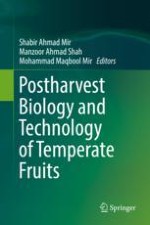2018 | OriginalPaper | Chapter
Postharvest Biology and Technology of Cherry
Authors : Manzoor Ahmad Shah, Shabir Ahmad Mir, Showket Ahmad Pala
Published in: Postharvest Biology and Technology of Temperate Fruits
Publisher: Springer International Publishing
Activate our intelligent search to find suitable subject content or patents.
Select sections of text to find matching patents with Artificial Intelligence. powered by
Select sections of text to find additional relevant content using AI-assisted search. powered by
